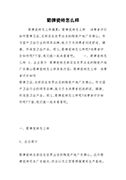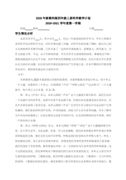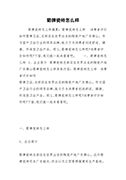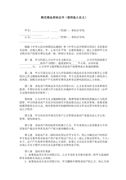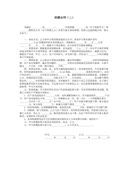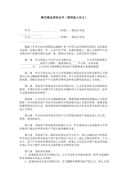《牛津小学英语》5B Unit 2 A telephone call (PartB, D and E)(通用15篇)五年级英语教案
《牛津小学英语》5B Unit 2 A telephone call (PartB, D and E)(通用15篇)
《牛津小学英语》5B Unit 2 A telephone call (PartB, D and E) 篇1
一、教学目标
1.能听得懂、会说、会用短语a bad cold ,a bad cough,a high fever, have a lot of rest.
2.能听得懂、会说、会读和会写句型what’s wrong with you? i’ve got …
3.能听得懂,会说和会读日常交际用语i’m sorry to hear that.
4. 能听得懂、会说、会表演e.read and act.
5. 培养学生关心他人的好习惯.
二、教学重点
能听得懂、会说、会表演e.read and act.
三、教学难点
能听得懂,会说和会用what’s wrong with you? i’ve got …,have a lot of rest.
四、课前准备
教师:多媒体课件、录音机、图片若干,药瓶等。
学生:预习课文,纸。
五、教学过程
step1:preparation
1.free talk
2.play a game:listen and touch.
3.sing a song
4.t:are you happy today?
s1:yes,i am.
t:but i feel hot.how do you feel now?
s1:i feel….
t:i can get a …for you.
s1:thank you.
s-s make some dialogues.
step2:presentation
1.s: how do you feel now?
t:i feel cold.i’ve got a cold.
teach : a cold?a bad cold? i’ve got a cold.(ss)
t:look,i’ve got a toothache.i’ve got a headache.(做动作)
can you say and do like me?
2. t:what’s wrong with you?
s:i’ve got a …
teach:wrong?what’s wrong with you?(ss)
3.s:what’s wrong with you?
t:i’ve got a fever.
teach:fever?a high fever?i’ve got a high fever.
(同法teach: cough?a bad cough?i’ve got a bad cough.)
t—s,s-s make some dialogues.
4. t:what’s wrong with you?
s:i’ve got a …
t:i’m sorry to hear that.
t:听到别人病了,要学会关心。
teach: i’m sorry to hear that.
5.ss practise part d
6.t:you look ill.i think you’ve got a fever.
let’s go to see a doctor.
(教师扮演医生)
t:what’s wrong with you?
s:i’ve got a fever.
t:anything else?
s:i’ve got a …,too.
t:open your mouth and say ‘ah’
s:ahhh.
t:you’ve got a cold.take some medicine and have a lot of rest.
s:ok.
teach :rest? have a rest?have a lot of rest
have a good rest
s-s
7.read and act.
step 3.presentation
1.i’ve got a stomach ache today.i want to go to see a doctor.you’re doctors.
oh,there are many rooms in the hospital.
s:what’s wrong with you?
t:i’ve got a stomach ache.
s:anything else?
t:i don’t want to eat food.
s:take some medicine and have a lot of rest.
(出示四个科室---内科、牙科、骨科、耳鼻喉科卡片)
内科:take some medicine,stay in bed ,have a lot of rest,drink some hot water,don’t eat rich(油腻的) food .don’t drink cold drink…
牙科医生(dentist):don’t eat sweets,brush your teeth…
骨科:stay in bed.don’t jump and run.have a lot of rest…
耳鼻喉科:have a good rest,take some medicine,don’t listen to the walkman…
s-s make some new dialogues.
2.give you a proverb
a good medicine tastes bitter.
step4:homework
1.copy the new words.
2.complete part d
3.make a new dialogue like part e.
听课随想
1.本节课的重点是让学生学会关心他人的身体情况。在free talk环节就注意到了与学生情感上的沟通,为下面的教学打好基础。
2.在巩固操练环节中,设计了一个真实的去医院看病的情景,并教授了一些看病的基本知识,让学生带着真实的任务投入操练,使之真正成为交际工具。
3.环节间的联系还有待加强,say a rhyme 的环节可以放在医生给出建议之前进行,这样层次会更清晰。
4.学生在表演时还是像背书,有些言不由衷,要让学生清楚自己的角色,把握好自己要说的内容。
5.要将看病和课题联系起来。如通过打电话来谈论病情。
《牛津小学英语》5B Unit 2 A telephone call (PartB, D and E) 篇2
教学内容:f. play a game g. listen and repeat
教学目标:
1.通过游戏,复习巩固本单元所学的知识。
2.帮助学生了解字母组合or在单词中的发音规律。
3.通过观察、听录音,复习检查对知识掌握情况,并进一步提高听力水平。
教学重点:能熟练掌握本单元所学的词、句,并能灵活运用形容词的比较级。
教学难点:根据所听内容,做出正确判断。
教具准备:录音机、磁带、词卡等。
教学过程:
step1 warm up
1. greetings
2. listen to a song: i wish i was taller!
step 2 revision
1. listen and repeat(a部分)
2. read the text in groups.(分组分角色朗读a部分对话)
3. look and read.
①出示图片背面,生猜单词。
②出示词卡(形容词原形)生抢答说出其比较级。
③教师读单词,只展示口型,不出声,生猜单词。
4. look and write
①出示图片,生写出相应单词。
②出示形容词原形,生写出其比较级。
5. look and say
出示c部分图,根据提示,生与生之间进行对话。
step 3 play a game
1.教师指导生读懂游戏内容。
2.讲解并与生示范游戏规则。
3. groups work.
step 4 listen and repeat
1.指导看图,谈论图意,从而引出单词:bird, girl, skirt, t-shirt
2. listen to the tape.
3. read after the tape.
4.体会并总结发音特点,鼓励生归纳。
5.read the sentences.
step 5 do exercises(b部分)
1. look at the pictures and talk about then.
引导学生讨论四幅图中人物的特征,告诉学生抓住人物的主要特征听录音,并进行判断,如:p1: the girl is fat. p2: the girl is short. p3: the girl is tall. the girl’s eyes are big.
2. listen to the tape.
指导生记录关键词语
3. listen and repeat.
4. listen and find.
5. listen and check.
板书内容:
词:bird, girl, skirt, t-shirt
句子:the tall girl in the yellow skirt and the blue t-shirt has a bird.
板书设计:
教后笔记:
《牛津小学英语》5B Unit 2 A telephone call (PartB, D and E) 篇3
一、教学理念
《英语课程标准》提出“学生的发展是英语课程的出发点和归宿”。 因此在本堂课的教学设计中,我充分围绕“学生是英语学习的主人”这一主题,让学生在情境中积极主动地探究语言知识,培养了他们高度的参与意识,提高了他们的学习积极性,让他们通过活动获得知识,形成能力。
根据这一主题,我将这一堂课定位于“活动”这一主要形式上,从以下几方面着手,进行了教学设计:
1、注重学生学习兴趣的激发。
学习是学生的自主行为。我们的教学更重要的是唤醒和激发学生主动参与学习的意识,使学生产生学习需求,因为兴趣是儿童认知活动的动力,最好的学习是学生对所学有内在兴趣。在本堂课中,我从学生所喜爱的游戏、比赛及身边的事物和情境入手,充分调动他们的积极性,激发他们的内驱力,变“要我学”为“我要学”,由被动地学转为主动地学。真正体现了教学的艺术不在于传授本领,而在于激励、唤醒、鼓舞。
2、营造和谐的课堂氛围。
现代教学论认为,民主、和谐、宽松的课堂教学氛围是学生自主学习、主动发展的关键所在。因此,在本堂课中,我采用了合作学习的方法,充分体现了师生间的民主合作性,课堂上师生合作、生生合作,平等讨论、相互补充的气氛极浓。给学生提供充分展示自己的机会,张扬自己的个性。学生无拘无束、轻松愉快地用英语表达自己的见解,在实践中学习语言,在想象中发展思维,在交流中提高能力。
3、让学生获得成功的喜悦。
苏霍姆林斯基说:“成功的欢乐是一种巨大的情绪力量,它可以促进儿童好好学习的愿望。请你注意无论如何不要使这种内在力量消失,缺少这种力量,教育上的任何巧妙措施都是无济于事的”要想促进学生主动发展,在教学过程中就要创设使学生能够获得成功的条件和情境,才能有效地培养学生的自信心,才能激发学生的学习主动性。在本课的教学中,我让学生自己用所学自编小诗、表演对话,不仅把学习的主动权交给学生,而且放手让学生自主学习实践。学生通过讨论探究,交流实践,获取了知识,发展了能力,获得了成功的喜悦。
4、在大胆设想中培养学生的综合能力。
德国诗人海涅有句名言:“思想走在行动之前,就如闪电走在雷鸣之前一样。”只有观念先行,才能产生与时代相适应的教学思想和教育模式。
在本课教学中,我充分贯彻新课程理念,运用了任务教学法,并把它与情景教学法、交际法和多媒体很好地结合,落实到各项活动中。学生通过自己体验,探索学习语言,又通过各种活动来操练语言知识,自己动手、动脑、动口、动眼、动耳,提高了综合语言运用能力,发展了思维。
总之,在设计本课的教学时,我觉得不仅要加深了学生对语言知识的理解,更要转变学生学习的方式,让学生放松身心,敢思、敢想、敢说、敢写;发展他们的思维,这样才能让他们荡起快乐的心灵之舟,在英语学习这片蔚蓝的大海上扬帆远航。
二、教学详案
1、教学目标:
1)知识与技能目标:
a、能听懂、说出词汇 open, close, eat, drink, draw, read, write, copy。
b、能听懂、并用祈使句及其否定句"don't ... ..., please"。
2)运用能力目标:
能用句型"don't ... ..., please"请他人干某事和不要干某事。
3)素质教育(文化、情感态度、策略)目标:
a、通过本堂课的教学,让学生明白在某些场合能干某事和不能干某事。
b、进行必要的文明礼貌教育。
2、教学重点:
1)词汇:open, close, eat, drink, draw, read, write, copy。
2)句型:"don't ... ..., please"。
3、教学难点:
词汇和句型的发音,让学生注意发音到位。
4、课前准备:
1)多媒体课件。
2)学生带一些食品饮料类的实物,教师带好奖品、盒子等物品。
3)将学生按合作小组的座位排列。
5、板书设计:
unit 8 in class nov. 25
don't ... all right.
... , please.
draw an apple apple
6、教学步骤:
warm up
1) chant: please stand up.
2) sing an english song: go to school
(全班进行热身活动,使学生在一开始就情绪高涨,调动他们的热情,提高学生的积极性和学习兴趣,并沟通了师生之间的感情。)
greetings
1)教师和全班同学打招呼。
2)教师和个别学生用以下句型交流:what's your name? your name,
please. what's this/that in english? where is it? is this/that your ...?
(因为在本课中将会带到一些实物的名称和有关地点的介词短语, 在这里既是交流,也是复习,为下面的学习打下伏笔。)
activities
1) let's play. "follow me."
让学生跟着教师做以下动作:stand up. get up. go to school.
have lunch. go home. watch tv. go to bed. sit down.
2)play a game. "simon says"
当老师说“simon says:'get up'”时,学生做动作;但如果老师不
说“simon says”,学生则不做动作。
(游戏的目的是让学生在活动中自然而然地进入到新的句型中去,
激发了学生英语学习的兴趣。)
presentation
1)新授单词:open , close。
在学生做完游戏后,对他们进行表扬:i think you're so clever.
i'll give you a present.拿出一个盒子,who wants to open the box? 打开后
学生会又发现一个书包,oh, who can open the school bag?打开书包又是一个笔袋,学生打开笔袋后,在里面发现了一些“苹果”(用红色的纸做的小礼品)。再让学生帮忙收拾这些东西:close the pencil case.close the school bag. close the box.表演open, close的学生分别可获得“苹果”的小奖品。
多媒体再打出单词:open 和close,进行拼读。然后,让学生用两个词语组词。
(这里新授单词又是一个游戏,学生一点都没有感到枯燥,学习兴趣反而更加浓厚。)
2)新授句型:don't... ..., please.
多媒体打出情境:天气很冷,不能开窗,要关窗。让学生在情境中,一下子就理解了don't... 的句型。
给出两个盒子: i want a pencil sharpener. who can help me?然后请学生don't open this box. open that box, please.两两表演,操练句型。
(这里句型的教学始终在情境中进行,体现了“生活英语”的宗旨。)
3)新授单词:eat和drink
在让上一环节表演后,给表演的学生“苹果”奖品,并巧妙地问:do you like apples?学生回答:yes, i do.老师紧接着:i like apples. ilike to eat apples and drink apple juice.引出单词eat 和drink。
新授单词后,拿出一盘食品和饮料,让学生看着实物,用eat和drink 组词,说对的小组可获得这些食品和饮料。
分完食品和饮料后,教师自己拿出食品,和学生用don't eat...eat ..., please. 进行交流。并分成小组操练。
(这一环节,我和上一环节中用多媒体创设情境不同,采用了用实物创设情境,拓宽了英语学习的渠道,激发了学生进一步学习英语的欲望。)
4)rhyme: open, open, open the door. close, close, close the window.
eat, eat, eat the apple. drink, drink, drink the juice.
说完这首小诗后,让学生用这种节奏自编小诗。
(这里,我让学生用自己所学来自编小诗,让学生体验了成功,既是课堂的调节,又让他们在轻松愉快的节奏中巩固了知识。)
5)新授单词:draw 和read
t: we all like apples. and we like to eat apples.can you draw an apple? look, i can draw an apple. ( draw an apple.)
it's an apple. i can read it. "apple" can you draw and read?
拿出纸和笔,在上面画画并读读。然后教学单词:draw read
新授单词:write 和 copy
(让学生自己动手体验了语言的功能。)
t: we know"draw and read". can you write them on the paper? ...
let's copy them.
新授单词:write和copy
将这四个单词放在一起,用动作表演,然后进行listen and do, do and listen的活动。
6)用simon says的游戏巩固这些动词,并加上don't ...句型。
(这一环节中,我又采用了全身活动法来新授单词和巩固句型,让他们的身心都受到了感染,从而能与教师产生共鸣,产生主动参与学习的热情。)
practice
给出图片情境,小组合作操练对话:don’t … …, please. all right.
1、 公共汽车上,请他人不要坐脏座位,坐在干净的座位上。
2、 时间晚了,爸爸让杨林不要看电视了,去睡觉。
3、 要在厨房读书,到书房读书。
4、 要在课桌上写字,在本子上写。
(将所学语言和生活相联系,培养学生语言的运用能力。)
activities
1) 小组竞赛:抢答,发现了电影院中哪些不文明的行为。
(引导学生用新的表达法运用到生活中,在运用中学习使用并巩固
新的表达法)
2) 给出课堂教学情景,让学生讨论哪些行为在课堂里不能做,自己该
怎样做。
(将所学语言知识转化为学生自己的能力,去解决生活实际问题,是本堂课的宗旨,这一环节进一步巩固了课堂所学内容,发展了他们的语言技能,并提高了学生的综合能力和自身素质。)
homework
1、 copy the new words.
2、 read the new words.
3、 make some suggestions for our english class.
(巩固所学知识。)
三、教学反思
本堂课力求通过一系列贴近小学生生活实际的、生动活泼的教学活动设计,激发学生学习英语的兴趣,培养学生自主学习以及团结协作的能力,使学生初步形成本课话题的会话能力。
1、教学过程中我根据学生的心理及生理特征,让“simons says”的游戏贯穿始终。这种游戏与教学相结合的方法,使学生在学中玩,玩中学,不仅不会感到语言学习的枯燥和疲倦,反而可以激发他们学习英语的兴趣,增强学生的自信心。
2、 教学时,我积极鼓励学生进行情景交际,让学生学用结合,学以致
用,在教师的指导下通过感知、体验、实践、参与和合作等方式实现任务的目标,感受成功。
3、教学过程中,我尽量注重环节与环节之间的有机联系,精心设计,努力使导入自然,不露痕迹,做到环环相扣,步步设营,启发学生,使之感受并且充分运用语言。
4、在整堂课中还是存在一些不足,有些操练教师的示范和讲解还不够到位,这些在以后的教学中还有待完善。
《牛津小学英语》5B Unit 2 A telephone call (PartB, D and E) 篇4
一、教学内容
《牛津小学英语》2a unit7 here you are第一课时。
二、教学目标
a) 知识与技能目标:
1.能听、说、读有关食品类单词a pie ,a cake, a hamburger, a hot dog。
2.能初步运用句型…,please.
b) 情感目标:
1.通过直观有效的教学方法,激发学生的学习兴趣,集中学生的注意力,提高学习效率。
2.通过学习,让学生更好地了解食品,养成不浪费的好习惯。
三、教学重、难点
a) 使学生能够理解并熟练掌握单词a pie,a cake,a hamburger和 a hot dog。
b) 初步运用句型…,please.
四、教学准备
生词卡、课件、练习题
五、教学过程
step 1 warming up
a) greetings
b) free talk
(1)t: what’s this?
s: it’s a pencil box/ rubber/ ruler.
t: look at the…
s: oh, it’s…
(2)t: what are these/ those?
s: they are carrots/ potatoes…
step 2 presentation
1.复习课堂用语(教师发出命令,学生边说边做动作)
stand up!
sit down!
open your book.
close your book.
touch your nose.
…
t: how are you?
s1:i’m fine, thank you.
t: how are you?
s2:i’m fine, thank you. and you?
t: oh, i’m not so good. i’m tired and feel a little hungry now. i want to go to the snake bar. let’s go together. ok?
ss: ok!
(出示课题)
3.教师拿出一个托盘,托盘里放着四个一模一样的盒子, 盒子里分别放着四种将要学习的单词(a pie、 a cake、 a hamburger、 a hot dog)
(1)t: look. what’s this?
it’s a pie.
learn: a pie(采用分组读,男、女声比赛读等方法操练单词。)
chant: a pie, a pie , i like pies.
(2)t: (教师又拿出一个里面放着蛋糕的盒子,请一名学生尝一尝并猜一猜)
is this a pie?
s:no, it isn’t.
learn: a cake(运用小组比赛读、看手势读等方法练习单词)
chant: a cake , a cake , i like cakes.
(3)t: what’s this in the box? who can smell and guess it? (教师再次拿出一个盒子,里面放着一个汉堡包,请一名学生闻一闻并猜一猜)
learn: a hamburger(运用小组读、看手势读等方法读单词 )
chant: a hamburger 、a hamburger,i like hamburgers.
(4)t: anything else? who can touch it and guess it what’s this in the box?(教师拿出最后一个盒子,让学生摸一摸、猜一猜)
learn: a hot dog(采用分组读,男、女声比赛读等方法操练单词。)
chant: a hot dog 、a hot dog,i like hot dogs.
4. play a game
what’s missing?
step 3 consolidation
活动手册p25
1、观察每组图中的物体,请学生说一说;
2、解释做题要求,请学生听句子答题。
step 4 homework
听录音,跟读b部分生词。
《牛津小学英语》5B Unit 2 A telephone call (PartB, D and E) 篇5
教学内容: partb:rectangle,square,triangle,diamond,circle,star
partc句型:what shape is it\the…? it’s a….
教学目标:
1.能掌握形状类有关字词。
2.能较熟练地对各种物体的形状进行描述。
3.热爱生活,主动发现,能将形状有关知识运用于实际生活中。
教学重点:能听懂、会说、会读形状单词与询问形状的句型。
教学难点:形状的区分与发音。
教学准备:课件,flash歌曲《twinkle,twinkle,little star》,印有相应单词的六种形状纸片,三组三角形,皮筋和各种形状的实物。
教学过程:
step1:warming-up
1. greetings
2. let’s play a game: who thinks fast? for example: i say “make” you can say: “make a puppet”, make—(让学生组词),同样play—, sing—.
[通过自由交流,营造轻松、快乐的氛围,让学生进入到英语学习的状态中去。让学生组词,使其活跃思维,最后操练单词sing和词组sing a song引出下面的歌曲。]
3.t: i like singing ,do you like singing ?now,let’s listen to a song.(播放flash歌曲)
[以歌曲为铺垫,引出“star”的教学。并以播放flash的形式激发学生学习热情。]
step2:presentation
1.教学“star”
[刚才的歌曲中出现了单词“star”,紧接教学,过渡自然。]
t: the song is 《twinkle,twinkle,little star》.what is the “star”?
s: 星星.
t: look, i have a star. (出示星形纸片,操练单词star)
now, i have a question. (板书)what shape is it? this lesson we’ll learn about shapes. first, let’s read these words. (多媒体出示:tape, grape, cake, table及其字母a的发音,操练单词shape)
t:(多媒体展示)the star means星星,also can mean 星形。can you answer “what shape is it? ”(教师示范,师生互动操练what shape is it? it’s a star.)
2.教学“rectangle”
(将星星贴于黑板上) t: now, where’s my star?
s: it’s on the blackboard.
t: what shape is the blackboard? please ask me?
s: what shape is the blackboard?
t: it’s a rectangle. (出示长方形纸片,操练单词rectangle及其句型what shape is it? it’s a rectangle.)
t: can you find some rectangles in our classroom? (让学生在教室里找长方形实物)
3.教学“square”
(出示一个盒子) t: what shape is it?
t: it’s a rectangle.
(出示另一个盒子) t: is it a rectangle?
s: no.
t: it’s a square. (出示正方形纸片,操练单词square及其句型what shape is the box? it’s a square.板书:what shape is the …?)
work in pairs:多媒体出示钟,毛巾图片,操练句型what shape is the …? it’s a square.
4.教学“triangle”
t: look at my paper. what shape is the paper?
s: it’s a rectangle.
(折成正方形)t: what shape is it now?
s: it’s a square.
(折成三角形)t: is it a square?
s: no.
t: it’s a triangle. (出示三角形纸片,操练单词triangle及其句型what shape is the paper? it’s a triangle.)
work in pairs:多媒体出示树,三明治图片,操练句型what shape is the …? it’s a triangle.
5. 教学“diamond”
t: i have some triangles. i can make some shapes. can you do it?(请学生来用三角形拼图。可以拼成三角形,长方形,正方形和菱形。)
t: what shape is it? please ask me.
s: what shape is it?
t: it’s a diamond. (出示菱形纸片,操练单词diamond及其句型what shape is it? it’s a diamond.)
work in pairs:多媒体出示风筝,福字图片,操练句型what shape is the …? it’s a diamond.
6. 教学“circle”
(多媒体展示)t: the diamond can mean 菱形,also can means 钻石. now let’s listen to the song again. please pay attention to the diamond. (再次播放flash歌曲)
t: there are lots of stars in the sky. they like diamonds. how nice! there’s the sun and the moon , too. (多媒体展示,朗读the sun, the moon)what shapes are they? they’re circles. (出示圆形纸片,操练单词circle及其句型what shape is it? it’s a circle.)
work in pairs:多媒体出示足球,太阳图片,操练句型what shape is the …? it’s a circle.
step3:consolidation
1.t: we have leaned six shapes. they’re…
s: star , rectangle,square,triangle,diamond and circle.
t: let’s make some shapes.(让学生用皮筋框出各种形状)
2.let’s do another exercise(多媒体展示含有多种形状的一幅图画,让学生完成一份笔头练习:how many …are there? there is\are….集体校对)
3.there are lots of shapes in our life. can you find them?(让学生在生活当中寻找形状:the … is a ….)
step4:homework
1.look for the shapes and talk about them.
2.finish part c on your books.
板书:
unit 9 shapes
what shape is it\the…?
it’s a ….
《牛津小学英语》5B Unit 2 A telephone call (PartB, D and E) 篇6
教学内容:复习一,二单元,操练part b及part d
教学目标:
1 复习unit1,2.
2 完成书上b部分练习。
教学重点: 检查一,二单元四会单词及句型掌握情况,完成b部分练习。
教具准备:投影片,单词卡
教学过程:
step1 warm up.
1 greetings.
2 say a rhyme “run,rabbit,run!”
3 free talk
教师出示单词卡,采用连锁问答的形式,让学生运用形容词及副词的比较级操练前两个单元的句型.
step 2 play a game. guessing game : who is my friend?
(1)师:(my friend is a girl. her eyes are bigger than mine, but her hair is shorter, and she is shorter than me. she is good at pe, she runs very fast. and she runs faster than the other girls in our class. guess: who is my friend? play the game with your partners ,please.)
(2)指名学生描述(结合上一课时的家庭作业),其余学生猜。
step 3 默写一、二两单元的四会单词及句型。
step 4 操练part b look,read and respond.
1 读题,理解题意。
2 操练picture 1,
(1)投影出示picture 1,指导看图,师读问句,指名学生回答。
(2)work in pairs. 同桌问答操练。
3 group work.
每组选择三幅图,组员间相互讨论,进行问答操练。
4 检查练习情况。指名小组对话表演。
step 4 操练part d look, talk and write.
1 读题,明确题意。
2 教师出示表格,学生自己阅读表格,了解信息.
3 以su yang 或su hai 的身份做自我介绍.并就两个人的介绍作比较.
4 自由答题。
5交流,核对答案.
6学生根据示范自制表格,在小组内边介绍自己的情况边填写表格,然后在小组内交谈.
step 5 作业布置:
1 根据自己的兴趣爱好设计个人名片并做介绍.
2 把书上b部分答句写下来,并读两遍。
板书内容:
unit 4 review and check
name:___________ age:___________ height:___________ cm weight:____________ kg 50-metre ace:_______〃 high jump:___________m long jump:___________m
板书设计:
《牛津小学英语》6b unit 4 第二课时 来自98e范文网。
《牛津小学英语》5B Unit 2 A telephone call (PartB, D and E) 篇7
教学内容:b. look, read and learn. c. work in pairs
教学目的:
1.能听懂、会说、会读、和会拼写单词tall, young, old, heavy。
2.能听、说、读懂本单元中所学的形容词及比较级。
3.能听、说、读句型who’s taller than? is taller than。
教学重点:
1.掌握本部分所学的形容词及其比较级,并能运用于情景中。
2.掌握句型“who’s… than…? whose…is…?”。
教学难点:了解并掌握形容词比较级在语音与字形上的变化。
教具准备:
录音机.磁带.相关实物.图片等
教学过程:
step 1 warm up.
1. listen to a song: i wish i was taller
2. greetings
3. free talk
可围绕以下句型与不同学生展开:hello. good morning! nice to see you at new term. how old are you now? oh, you’re younger than me. look, he is tall. who’s taller than him? look at my scarf. it’s long. the scarf is longer than this ruler(随着手拿一尺子)…
step2 presentation
1. learn long, longer
①由free talk引出long, longer.并出示单词指导生朗读,并比较两词区别其间教师不断地出示实物,边比较边发音long-longer.
②practice in pairs
指导生利用现有实物练说long-longer
2. learn whose…is…, yours or mine?
①教师将围巾与学生围巾放在一起问:whose scarf is longer, yours or mine?并指导生回答。
②practice in pairs
生利用现有实物进行问答练习
③ss act.
3. learn old-older, young-younger
①出示图画,引导生观察,随机出示两组单词指导生朗读。
②操练句型: who’s…than…?
师随意问两个同学的年龄后;指着两个学生问其他学生:who’s older/ younger than…?并引导生回答。
4.出示单词:tall-taller, short-shorter, small-smaller
①引导学生根据发现的规律进行练读。
②总结比较级一般情况下的发音与书写规律。
5.出示big, fat, thin, heavy
①鼓励生写出比较级,并适当出示正确单词。
②强调特殊情况下比较级单词的变化规律。
③指导朗读。
5.拼读old, young, tall, heavy
step3 consolidation
1. listen to the tape and read after the tape.
2. look and read
出示图片进行比较,指导生认读。
3. work in pairs
①picture 1-2,出示挂图,师示范并随机板书句子。
②groups work.
出示相关图片,引导学生进行替换练习。
step 4 homework
1. listen to the tape and repeat.(b部分)
2. write the words of pant b two times.
3. make dialogues use the words.
板书内容:
句子:a: who’s… than…? b: …is.
a: whose…is… , yours or mine? b: …is, i think.
单词:b部分出示的单词
板书设计:
教后笔记:
《牛津小学英语》5B Unit 2 A telephone call (PartB, D and E) 篇8
教学内容:c. work in pairs d. listen and write
教学目的:
1.能熟练掌握句型“who’s taller than david? whose schoolbag is heavier, yours or mine?”并能灵活进行替换练习。
2.能听懂所听内容,提取有用信息,并用完成填空的方式重构信息。
3.在激发学生兴趣的基础上提高学生的听力。
教学重点:
1.根据提供的单词灵活替换句型。
2.根据所听内容完成信息重构。
教学难点:根据所听内容完成信息重构。
教具准备:录音机、磁带、图片等。
教学过程:
step 1 warm up
1.greetings
2. sing a song: i wish i was taller
3. free talk.
围绕本单元的b部分单词及句型“who’s…than….? whose…than…? as…as…”等句型结合学生实际与生进行闲谈。
step 2 revision
1. listen and repeat.(a部分内容)
2. look and read.
①出示b部分图片指学生读。
②小组竞赛方式,复习形容词及其比较级的读法。
3.look and write.
根据出示的单词,写出它们的比较级。如:old-older
4. look and say
①出示图片,引导生用“who’s…than…? whose…is…”进行对话.如:who’s taller than david? gao shan is. whose schoolbag is heavier, yours or mine? yours is, i think.
②出示单词,引导生替换。
old, young, long, tall, short, fat…
step 3 presentation
1. look and say
出示图片,指导讨论图片内容。
如: how many people are there in the photo? who are they? who’s older, the man in black or in blue? who’s younger, the woman in green or in purple?
2. listen to the tape.
指导生边听边记录关键词
3. listen and repeat
4. listen and complete
5. listen and check
6. read the sentences.
step 4 homework
1. listen and read part a.
2.选择完成c部分的替换练习,并与同位操练对话。
板书内容:
句型: who’s taller than david? gao shan is.
whose schoolbag is heavier, yours or mine?
yours is. i think.
图片(c部分.d部分)
板书设计:
教后笔记:
《牛津小学英语》5B Unit 2 A telephone call (PartB, D and E) 篇9
教学内容:《牛津小学英语》6b unit 3 asking the way复习本单元内容并完成补充练习。
教学目标:
1. 通过复习,使学生熟练掌握本单元所学的与问路有关的词汇。
2. 能较熟练地在情境中运用本单元所学的句型和日常交际用语。。
3. 能进一步掌握句型can you tell me the way…? how can i …及其答语。
教学重点:can you tell me the way…? how can i …?及其答语。
教学难点:能综合运用本单元所学的单词、句型和日常实际用语。
教具准备:本单元的单词卡,补充练习的听力磁带、录音机、一张自制城市交通图。
教学过程:
step 1 warm up:
1. sing a sang: excuse me
2. chant: where’s the bookshop?
3. free talk:
师生利用地图围绕本单元所学的单词、句型进行问路对话。
t:excuse me. can you tell me the way to…, please?
s:go along this street,…
t:how fat is it from here?
s:it’s about… away.
t:how can i get there?
s:you can take… and get off at…
step2 revision
1. 请学生复述或表演a部分会话。
2. 根据课文内容,教师提出问题,让学生判断正误。
step3 do some exercise.
教师指导学生完成本单元的补充习题。
1. a listen and number
①指导学生仔细观察每幅图的内容,看清图意。
②认清每幅图的场所。
③听录音排序号。
2. b listen and match.
①指导学生说出图中的人物、地点和交通工具。
②听录音连线。
3. c look, read and write
①指导学生看图口头说出完整的句子。
②拼读单词和词组。
③根据图意填词或词组。
4. d read and judge
①指导学生认真阅读短文。
②根据题目中的句子,在课文中找出相应的内容画出来,进行比较,判断句子的对错。
5. e look, read and complete.
①指导学生看图,根据图上的内容口头完成句子。
②在学生整体朗读对话后,再书面完成。
6. f read and write
①仔细阅读句子,联系所给情景,理解句意。
②根据内容给对话排序。
7. 集体校对答案,可指名回答问题。
step4 homework
1. 熟读并抄写补充练习中f read and write图1和图3的对话。
2. 思考:nancy想来我们这儿做客,你能为她推荐两个本地最著名的风景区或最值得去的地方并为他指路吗?课后分小组自编情景对话并画出简图。
板书设计:
《牛津小学英语》5B Unit 2 A telephone call (PartB, D and E) 篇10
教学内容:综合实践课
教学目标:
1. 以训练学生基本语言技能为目标,培养学生大胆用英语表达的勇气,养成用英语思维的习惯。
2. 以听说读写的形式,综合训练学生对本课单词、句型的理解应用。
3. 鼓励学生合作学习,共同发展。
教学重难点:培养学生综合运用语言的能力。
教具准备:录音机
教学过程:
step1 group work:what have you learnt?
1. 小组内交流本单元所学内容。(分单词、句型两大块,每块再分重点及次重点)。
2. 记到笔记本上,互相读一读,问一问。
3. 全班交流。
step2 listening exercise 听力练习。
1. listen and judge.(完成练习册a部分)
①look at the pictures.
②what can you see?
③listen to the tape and judge.
④check the answers
2.look, listen and choose.
①look at the sentences.
②listen to the tape and choose the correct answer.
③check the answers.
step3 oral exercise 口语练习
以jump为话题,小组合作,进行英语会话。
1. group work. 小组内进行。
2. english show. 选出优秀选手,全班展示。
step4 reading work. 完成练习册f部分。
1. read and put the sentences in the right order.自由读短文,完成排序。
2. 指名读。
3. 核对答案。
4. 齐读短文。
step5 writing work. 写话练习
练习形式:每组发一张纸,以i’m not happy开头,每人接一句,一直接下去,5分钟之内完成合作。
教师快速阅读一下,再分发下去,学生互相评价,最后齐读范文。
step6 布置作业
1. 完成练习册14、15、16、页。
2. 你能发现多少单词:aslowalkwellateanimalowatchavexercise
板书内容:
(请合理安排)
板书设计:
《牛津小学英语》5B Unit 2 A telephone call (PartB, D and E) 篇11
教材依据:《牛津小学英语》6a unit 7 at christmas a部分。
教学目标:
1. 学生能听懂、会说、会读和会拼写单词:watch, teapot, wallet, hairdryer, calculator, skateboard, mine, yours, his, hers, theirs.
2. 学生能听懂、会说、会读和会写句型:whose … is it? whose … are they?及其回答。
3. 学生初步掌握a部分的对话。
教学重点:b部分单词和句型
whose … is it? whose … are they?及其回答。
教学难点:名词性物主代词的用法。
课前准备:多媒体课件。
教学过程:
step 1. greetings. (会话导入)
1. t: hello, boys and girls. my name is vicky, your name please? s: my name is …
t: nice to meet you. s: nice to meet you, too.
t: how are you? s: fine, thank you. and you? t: i’m fine, too.
2. t: i want to make friends with you. let’s sing a song <make new friends>.
这一步骤主要是通过询问学生姓名,互问身体情况等与学生拉近距离,并且通过演唱歌曲<make new friends>让学生感觉到老师和他们的距离很近,同时也是让他们做好上英语课的准备,调动学生说英语的积极性。
step 2. learn the new words. (新授b部分单词)
1. show a calendar. t: today is the 25th of december. it’s christmas day.
show the pictures and the words ‘christmas, christmas day, merry christmas, christmas tree.’
2. t: on christmas day, people always sing <ring, ring, ring the bells>
listen to the song.
让学生在特定的情境中展开对话而不是进行机械的无意义的对话,这样比较符合小学生的学习特点,因此我采用圣诞节这一情境带出圣诞快乐、圣诞树等词语。并且让学生听一听人们通常在圣诞节这一天唱的歌曲来感受圣诞节的气氛,同时也是为下面用圣诞礼物引出新单词做铺垫。
3. t: merry christmas! i have some christmas presents. please look at the picture.
draw a watch on the blackboard.
t: what is it? s: it’s a watch.
write the word on the blackboard, students read and spell the word.
4. draw a teapot on the blackboard.
t: it’s a teapot.
write the word ‘teapot’ on the blackboard, students read the word after the teacher.
5. draw a wallet on the blackboard.
t: it’s a wallet.
write the word ‘wallet’ on the blackboard, students read the word after the teacher.
6. draw a hairdryer on the blackboard.
t: it’s a hairdryer.
write the word ‘hairdryer’ on the blackboard, students read the word after the teacher.
7. draw a calculator on the blackboard.
t: it’s a calculator.
write the word ‘calculator’ on the blackboard, students read the word after the teacher.
8. draw a skateboard on the blackboard.
t: it’s a skateboard.
write the word ‘skateboard’ on the blackboard, students read the word after the teacher.
9. read all the words together.
传统的出示图片然后新授单词对学生们来说已经没有了新鲜感,因此在这一步骤中我并没有这样做,而是用简笔画将这些东西画在黑板上然后再学习。因为 watch这个单词学生是学过的,学生比较容易掌握,因此我就让学生自己说出这张图片代表的单词。接着我就边画边说出今天要新授的单词,学生看得认真也听得认真。
10. play a game. (做游戏)
t: i will give you 30 seconds. you can make phrases using the new words. let’s see how many you can make.
make some examples. students work in groups.
这是个以比赛形式进行的游戏,学生在掌握了今天新授的单词后一个接一个的用这些单词来组词,组词最多的小组获胜并能获得老师的奖品。这一步骤不仅是巩固今天新授的单词也是复习了以前学过的一些知识,学生的积极性也非常高。
step 3. learn the new sentences. (学习新句型)
1. show a picture of a teapot. t: who is it from? 很快的闪动一下helen的图片。
s: it’s from helen.
show a picture of a hairdryer. t: who is it from? s: it’s from yang ling.
show a picture of a skateboard. t: who is it from? s: it’s from mike.
2. show a picture of two wallets. t: who are they from? 很快的闪动一下su yang and su hai的图片。s: they are from su hai and su yang.
show a picture of a ruler and a pencil. t: who are they from? s: they are from ben.
这个句型以前有接触过并且对学生来说比较简单,因此我没有要求学生跟读然后再操练,这样学生就不会觉得老师在教一些自己会的东西。同时出现的人的图片非常短暂,学生必须高度集中注意力才能看清楚,这就充分能发挥学生的主体作用。
3. t: oh, the ruler is from ben. it’s mine.
show the new word ‘mine’. students read and spell the word.
show the sentence structure: whose is it? it’s mine.
ask and answer using their things.
4. take two or three things of one student. t: whose are they? s: they are mine. t: oh, they are yours.
show the new word ‘yours’, read and spell the word.
5. look at the picture of a calculator. ask some students to read the word. listen and repeat the word. t: whose is it?
students listen and learn the new word ‘his’.
show the sentence and read: it’s his.
look at the picture of a magazine. listen and repeat the word. t: whose is it?
students listen and learn the new word ‘hers’.
read the sentence: it’s hers.
6. look at the picture of two skateboards. ask some students to read the word. listen and repeat the word. t: whose are they?
students listen and learn the new word ‘ours’.
t: they are theirs.
show the word. read and spell the word.
对于小学生来说名词性物主代词是个难点,我使用了学生课桌上的东西来教学。如拿出自己的一本书说:it’s mine.(这是我的。)拿起学生课桌上的两样或三样东西,提问:whose
are they?学生自然会回答:they are mine. 这时就顺势说出they are yours.并教学新单词yours。这样的方法学生很容易就理解了这些单词和句子的意思,同桌操练起来也非常方便。
7. let’s chant.(有节奏的朗读)
watch, watch, it’s mine, mine. skateboard, skateboard, it’s yours, yours.
hairdryer, hairdryer, it’s his, his. calculator, calculator, it’s hers, hers.
wallets, wallets, they’re ours, ours. teapots, teapots, they’re theirs, theirs.
将名词性物主代词教学完后我设计了这样一个chant,让学生通过有节奏的朗读来巩固所学的单词。
step 4. listen, read and say. (学习a部分课文)
1. t: the cds are su yang’s. they’re her christmas presents. let’s go back to jim’s grandpa’s house. listen to the tape and tell me whose are these presents.
students listen to the tape and do the exercise.
check the answers..
2. read after the tape.
read part a together. work in pairs and act.
这一步骤是对上面教学的单词和句型的一个全面的学习。首先我要求学生听录音完成书本上的一个比较简单的连线题,然后再根据这一主线来跟读课文并分角色朗读。虽然课文很长但学生基本都能掌握,因此学习起来很有信心,效果也比较好。
step 5. say goodbye.(结束本课并布置课堂作业)
1. t: christmas is coming. i wish you a merry christmas. let’s sing a song <we wish you a merry christmas>.
课上到这里学生和老师都比较疲倦了,因此我设计了演唱<we wish you a merry christmas>这首歌,让学生和老师一起唱起来,在轻松愉快的氛围中结束本课。
2. assign the class work: make a christmas card for your teachers.
《牛津小学英语》5B Unit 2 A telephone call (PartB, D and E) 篇12
unit 6 planning for the weekend
连云港市赣榆县实验小学 姜竹晓
单元教材分析:
本单元主要围绕“周末活动计划”这个话题开展各项活动,所涉及的日常交际项目有介绍、打电话、询问和建议等,其中以询问what are we going to do…?及we’re going to…为重点内容。
教学目标:
1、能听得懂、会说、会读和会拼写单词plan,picnic,play,take part in。
2、听懂、会说和会读单词project,zebra,africa,elephant,concert,outing,beijing opera show,singing contest,sports meeting。
3、能听得懂、会说、会读日常交际用语is that gao shan? yes, speaking. by the way,what are you going to do…?等。
4、能听得懂、会说、会读和会写句型what are we going to do…?we’re going to…
5、了解字母组合ow在单词中的读音。
6、能唱歌曲will you join me?
教学重难点:
1、能听得懂、会说、会读和会拼写单词plan,picnic,play,take part in。
2、能听得懂、会说、会读和会写句型what are we going to do…?we’re going to…
教具准备:课件(图片)、录音机、磁带、小黑板、投影片、教学挂图等。
课时安排:
第一课时:b look,read and learn c look and say
第二课时:a listen,read and say
第三课时:d listen and write
第四课时:e read and number
第五课时:f play a game
g listen and repeat
h sing a song
第六课时:综合练习课,完成补充习题。
友情提示:
1、本单元开始学习一般将来时,教师要讲清楚一般将来时的意义、构成和时间标志。
2、注意归纳总结at,on,in,with,for,of…的用法。
3、教师要讲清楚一些语法知识。例如,乐器类前加the ( play the piano ), 球类前不加the ( play football )。又如,介词的用法( for your class project, at the bus stop, at 10:30, look at, in the zoo, be from…, come home, in new york, with his friends, at the shopping centre, near their school, in front of the garden theatre, plans for the weekend, in the school…)。又如,名词复数的用法(buy some presents, buy some kites, see his parents…)。
《牛津小学英语》5B Unit 2 A telephone call (PartB, D and E) 篇13
《牛津小学英语》4a第七单元(第一课时) 包丽琴 教学目标:1、 掌握数字1-10。2、 了解13-19,20-90的数字构成规律。3、 掌握四会句型what’s the time, please? it’s …4、 听懂、会说句型it’s late. what time do you…? i…at…/at…5、 培养学生在实际环境中运用语言的能力。教学重点:了解13-19,20-90的数字构成规律。教学难点:1、掌握四会句型what’s the time, please? it’s …2、培养学生在实际环境中运用语言的能力。教具准备:1、本单元教学课件。2、准备有关数字的卡片。3、有关头饰。4、录音机,磁带。(两盘)教学过程:一、 warming-up(课前热身)1、 greetingst: hello, boys and girls, can you do like this?(示范) show me your hands. follow me,please.(教1-10手势)2、sing a songt: good. i’m so happy today. are you happy?s: yes.t: let’s sing a song together.ok?s: ok.3、i say they do. 我任意报出1-10中的数字,让学生做手势。4、学习late,准备上课。t: oh, it’s late. it’s time for our english class.(做紧张状,引出late.)ok, are you ready for class?s: yes.t: all right. class begins.s: …二、 revision(复习)1、单个数字(1-10)t: look, i have some number cards. can you read it? (指名读,强调teen) teen, teen, thirteen, thirteen.2、两个数字t: can you read this one?s: …t: good, together.3、钟面练习(整点) t: everybody, i have a clock. this is its hour hand and this is its minute hand. do you like it? s: yes. t: me.too. look at the clock. what’s the time? s: it’s nine. 跟读该句型5、 练习9:20t: how about this one? what time is it? s: it’s nine twenty.. t: you are so clever. (跟读twenty) 三、 presentation and practice (新授与练习)(一)新授数字1、9:25/9:28t: now, what’s the time?s: it’s nine twenty-five.(练习twwenty-five)t: how about this one?(9:28)2、课件出示21-29,要求齐读。3、9:30a: now,boys and girls, look at the clock,what’s the time? b: it’s nine thirty. a: yes. it’s nine thirty. (跟读thirty,小组练习)4、同理引出40、50。(跟读,开火车,齐读)4、领读20-50,强调ty的读音。5、出示几十和十几的对照表,让学生读一读。区别teen和ty。(二)新授句型1、出示课件get up。t: look at this picture, who’s she?s: it’s you.t: yes, it’s me. can you see a clock?s: yes. t: what’s the time?s: it’s six twenty.t: in the morning, i get up at six twenty.(跟读get up, at , i get up at six twenty.)t: ok. i get up at six twenty. what time do you get up?s: i get up at . (跟读句型,同桌练习)2、同理引导学生学习词组have breakfast, go to school, come home, 并把它们代入句型进行同桌练习、表演。3、do a survyt: this is a time table. who wants to ask me some questions?s: …t: (示范填表) you can ask your friends like this. (学生仿照填表,做调查,教师指导学生汇报调查情况)四.consolidation(巩固,学习课文)1、听录音。t: now, boys and girls, i want to introduce a friend to you. guess, who’s he?s: mike.t: good. he’s mike. who’s she?s: she’s mike’s grandmother.(跟读)t: in the morning, mike and grandmother are talking about something. let’s listen to the tape. then try to answer the question. ok?s: ok.t: let’s begin.2、回答问题。2、 跟读录音。3、 分角色朗读。4、 小组合作练习对话并表演。五、 homework结合本课所学句型,编一类似对话。
《牛津小学英语》5B Unit 2 A telephone call (PartB, D and E) 篇14
一、教学内容:《牛津小学英语》6b unit 6复习课
二、教学目标:
1、知识目标:熟练运用be going to表达计划或打算。
2、技能目标:能独立收集信息,并正确处理信息。
3、情感目标:保持英语学习的兴趣,能自信地用所学英语交流。
三、教学重难点:be going to 的灵活运用和综合运用。
四、教学准备:一段视频材料,一段听力材料,练习纸(师生每人一张)
五、教学过程:
step1: introduction
(1) 引入本课话题。
t: today we are going to review unit6, what’s the title of this unit?
ss: planning for the weekend.
t: right. in unit6,we learned “be going to” 这个句型来表达自己的计划或打算,比如plan for the weekend(板书单词weekend)或plan for tomorrow(板书tomorrow)
教师引导学生说出“plan for next week/month/year…等,并板书学生所说的短语)
(2) 学生根据下图提示,每人写一句话。
t: i’m going to have a birthday party this weekend. what are you going to do? please write one sentence about your plan.
play…
be going to
make…
have…
go…
see…
[设计意图]:复习课对学生的要求不能仅停留在口头表达上,而应是既动脑、动口,又动笔。通过写的活动让学生更加注意时态的时间意义及相应的动词形式,以提高学生的语言运用能力。
step2: group activities:
(1) 师生一起探讨如何完善这份计划
t: …is going to have a picnic this weekend. who is going to have a picnic this weekend,too?
s1: i’m going to have a picnic this weekend,too.
t:oh,really? you two come here, please. you are going to have a picnic this weekend. what time are you going to meet?(板书问句:what time are you going to meet?)
s1: we are going to meet at eight in the morning.
t:(向其他学生) do you have any questions about their plan? please write them down.
(学生四人一组讨论,并将讨论的问题写在一张纸上,站在讲台上的两位同学也同时讨论如何完善他们的计划)
[设计意图]:小组合作学习有利于学生积极参与课堂活动,并开动脑筋;让学生写出讨论的问题有助于学生注意单词的拼写。
(2) 各组派代表提问讲台前的两位学生。
step3: more practice
(1) 为了帮助学生复习,巩固和正确运用一般现在时和一般过去时,教师与学生进行如下对话:
t: i’m going to go fishing this weekend. i like fishing. do you like fishing?
s1: no, i don’t like fish.
t: ( to s2) does s1 like fishing?
s2: no, she doesn’t.
t: do you like fishing?
s2: yes,i do.i like fishing.
t: did you go fishing last weekend?
s2: yes, i did. i went fishing last weekend.
t: ( to s3)did s2 go swimming last weekend?
s3: no,he didn’t .
t: what did he do last weekend?
s3: he went fishing.
t: what did you do last weekend?
s3: i visited my grandparents.
t: how do you usually spend your weekend?
s3: i usually watch tv or play computer games at weekends.
[设计意图]:一句“do you like fishing?”将课堂教学由复习一般将来时巧妙地转入下个环节,通过师生之间的对话帮助学生复习所学时态,把对语言形式的训练变成了自然、有意义的交际活动,摆脱了机械、枯燥的语法训练模式。此外,连续提问的方式,以提醒学生认真倾听别人的发言,将看似个别训练的活动自然地变成对全体学生的训练。
(2) 用课件将一般现在时,一般将来时,一般过去时和现在进行时作对比,帮助学生梳理知识网络。
(3) 读故事并填空
学生阅读以下故事,并用单词的正确形式填空:
a running race
rabbit: hello, i’m a lovely rabbit.last time, the tortoise and i
(have) a running race. he (run) faster than me . i
(be) still not happy. now i’m (call)him.
rabbit: hi, is that mr. tortoise?
tortoise: yes, this is mr. tortoise (speak)
rabbit: are you free tomorrow?
tortoise: yes. what are you going to do?
rabbit: i (have)a running race with you tomorrow. would you like to come?
tortoise: sure. where are we going to (meet)
rabbit: in front of miss cat’s house.
tortoise: when?
rabbit: at nine o’clock.
tortoise: ok. see you tomorrow.
rabbit: see you.
[设计意图]:由句子到段落再到篇章的练习形式,让学生对不同的时态及其用法有了更为清晰的认识和理解。
step4: listening practice
教师出示视频,让学生做听力练习,并回答问题。
step5: consolidation and practice
教师呈现课前制作好的海报,给学生2-3分钟的时间阅读。
good news!
go to huangshanhu park this children’s dayby bus.
meet at 8:30, in front of our primary school.
go fishing in the morning.
have a picnic at 10:45 on the grass.
have a singing contest in the afternoon.
go back home at 4:10 by bus.
(2)分层作业:
教师给出短文的开头(如下):
last sunday was mother’s day. i for my mother. she was very happy. i was happy, too.
children’s day is coming…
学有余力的学生根据以上信息续写短文。中等水平的学生回答以下问题,然后连成一段小短文。
where are you going this children’s day?
how are you going to get there?
what are you going to do in the morning in the park?how about the afternoon?
are you going to have lunch at home?
what time are you going to get back home?
学习困难生根据所给信息完成下列填空练习:
sunny and warm wednesday, may 15th
children’s day plan
last sunday was mother’s day. i for my mother. she was very happy. i was happy too.
children’s day is coming. i’m going to huangshanhu park with my classmates by .
we’re going to meet 8:30
our primary school.
we’re going to in the morning.
we’re going to .
we’re going to at 4:10.
huangshanhu park is very beautiful. i’m sure we’re going to have a good time there.
[设计意图]:根据学生英语水平参差不齐的实际情况设计三个层次的练习供学生选择,让每位学生都能体验到学习成功的快乐。
step6: summary and homework:
教师总结本节课的重点内容,并布置作业:以小组为单位,续编龟兔赛跑的故事。
《牛津小学英语》6b unit 6教学设计 来自98e范文网。
《牛津小学英语》5B Unit 2 A telephone call (PartB, D and E) 篇15
一、教材分析:
《牛津小学英语》3a教材按“话题---功能---结构---任务”相结合的原则编写,内容贴近小学生的生活和学习实际。倡导教者从视听说入手,通过听、说、读、写、演、唱、画等丰富的语言实践活动,帮助学生获得良好的语音基础、初步的语感和用英语进行简单日常交流的能力。并培养学生的学习兴趣、学习自信心和良好的学习习惯,形成有效的学习方法和自主学习能力等。
根据英语课程标准,对教材进行灵活处理,本节课把unit 2.part b、d两部分组合成一个课时的教学内容,主要学习red、yellow、blue等八种基本颜色的单词,并运用句型what color is it? it’s…进行简单描述,让学生能将所学的语言知识与生活实际联系起来,真正运用到今后的生活和学习中去。
二、学生分析:
三年级的学生大都天真活泼,有强烈的求知欲。他们初学英语,对英语课有浓厚的兴趣和向往,在课堂上表现积极大胆、乐于实践,而且善于模仿,因此教师要把握好这一契机,通过组织丰富多样的教学活动来让学生充分体验语言实践的成功喜悦和信心,从而优化教学效果。但是,他们大都好动贪玩,有意注意时间还比较短,因此在课堂上教师也要注重运用激励和引导,把握好教学活动秩序的“松弛度”。
三、教学目标:
1、语言知识目标: 能听说、认读八种颜色的单词red,yellow,blue, green, orange,brown,black,white 。
2、语言技能目标: 能用句型what color is it? it’s…进行简单的物体颜色描述并能真正运用到生活中。
3、意识和情感目标: 培养学生的审美情趣和创新精神;让学生在活动中体验互帮互助的乐趣,培养学生的合作能力。
4、学习策略:从学生的学习和生活实际入手,融语言于情景之中,鼓励亲身实践;利用学生的信息差,通过同学间的合作,使学生在活动中手、脑、口、眼并用,加深学生对语言知识的记忆和运用。
四、教学策略:
1、教学方法:情境教学法、活动教学法和任务型教学。
2、教学手段:flash课件,录音机、单词卡片,八种颜色的卡纸,服装卡片,调好各种颜色的水数杯,大烧杯两个,小书签(作奖品用)。
五、教学过程:
i. warming-up
1、听录音唱英文歌曲《hello!》。
2、free talk
t: good morning s1: good morning,mr xie.
t: what’s your name? s1:my name is…
t: nice to meet you. s1: nice to meet you ,too.
【 通过师生唱英文歌曲和简单的问候,创设浓厚的英语氛围,并自然复习了之前所学的交际用语。】
ii.presentation
1、通过课件的动画显示,整体呈现新授内容,并用八种颜色的卡通小朋友来逐个呈现新授单词:
红色的卡通小朋友从集中的画面跳出: hello,i am red. red,red,red,i am red.→教师出示带颜色的单词卡片→反复领读单词。
2、让学生和八个颜色卡通逐个交朋友,动画显示:hello,i am red. nice to see you.引导学生说:hello! nice to see you, red .
(同样的方式呈现另外七个单词)
【 利用flash动画生动呈现语言知识,让学生获得感性认识,同时自然的结合了新旧知识。】
3、出示八种颜色的卡纸,逐个领读数遍(t:red, it’s red .),然后顺势呈现句型:
t:what color is it?
ss:red.
t:yes. it’s red.
(同样的方法用另外七张卡纸呈现,然后板书句型what color is it? it’s…)
4、以开火车或分组比赛的形式,用八种颜色的卡纸反复进行问答练习,初步识记所呈现的单词和句型。
【 将单词与句型的教学相结合,词不离句,即学即用。】
5、做实验,猜颜色。
教师出示一杯用颜料调好红颜色的水,
t: what color is it? ss: it’s red.
再出示一杯用颜料调好黄颜色的水,
t: what color is it? ss: it’s yellow.
将两种水进行适量的混合(教师像魔术师一样夸张神秘的动作),
t: what color is it? ss: it’s orange.
( 同样的方法进行黄与蓝、红与黄等调色的尝试 )
【 让学生结合美术常识仔细观察教师实验后回答问题,既为学生创设了感知和操练语言知识的情景,又培养了学生的观察力和注意力,学生的兴趣十分浓厚,教学效果不言而喻。】
6、看课本并跟录音朗读,检验和纠正学生的发音。
iii. practice and consolidation
1、快速竟猜游戏:屏幕高速闪动一动物的画面,让学生用英语猜一猜每个动物的颜色,对猜对的学生给予奖励。
【 竟猜游戏是孩子喜闻乐见的活动,活动时学生的注意力高度集中,充分调动了学生的积极性,将知识机械操练情趣化。】
2、小小设计师:小组同学齐动手,把不同的服装卡片(课前给每小组发四张)涂上自己喜欢的颜色,然后小组间相互展示或上台介绍(要求用句型it’s red/blue…)
【 动手操作与语言实践相结合,让学生学会欣赏颜色与美,同时体现英语教材与跨学科知识的整合。】
3、看屏幕说歌谣:把本课所学的句型和八个单词套上儿歌《两只老虎》的旋律,用问答的形式分组或分男女角色进行说唱。
【 让学生在宽松、有趣的氛围中巩固本课所学的内容,虽然课临近结束,但学生的兴趣犹存。】
ⅳ.homework
1、教教自己的父母或兄弟姐妹所学的颜色单词,将身边事物的颜色说给他们听。
2、制作一幅简单的粘贴画,在画的不同部分标上颜色单词,下节课向同学展示。
【 作业应突出操作性、实践性和兴趣性;将作业延伸到生活、家庭,有利于促进家庭英语学习环境的形成。】
六、板书设计:
unit 2
red 卡片 yellow 卡片
blue卡片 green 卡片 what color is it?
orange卡片 blown 卡片 it’s…
black卡片 white 卡片
《牛津小学英语》3a unit 2 .part b、d教学设计 来自98e范文网。


